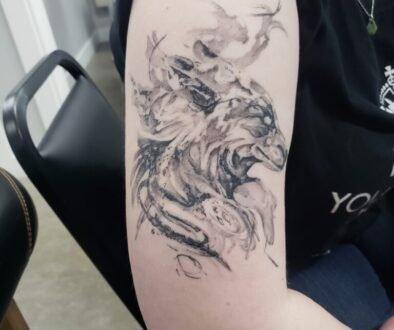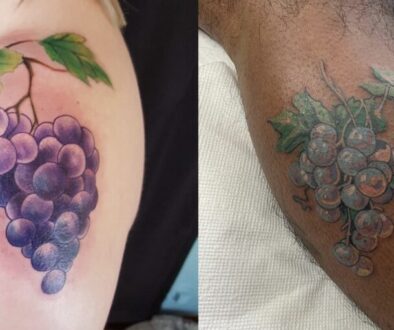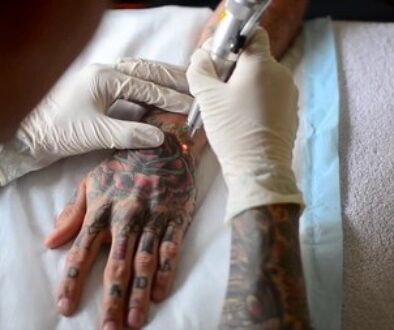Different Techniques Used In Tattooing
|
Listen to this Article::
|
With any trade, the fundamentals you learn at the beginning will influence your future ability to learn and adapt. In reality, any tattoo artist who has been working for more than a decade will tell you that the machine, pigment, or any other disposable variable is second to the skill of the artist.
A friend once told me, “The Bushido is always dangerous, regardless of the weapons they possess” – this statement makes more sense to me the longer I stay in the industry. Regardless of what tool I am using, the fundamentals I learned along the way make it possible to achieve legible, long-lasting tattoo work. In essence: You don’t need a $1000 machine to make a good tattoo – you need good technique to make a good tattoo.
Before we move on to techniques, let’s take a look at what happens when a needle strikes the skin during a tattoo:
Table of Contents
Basic Tattooing Techniques – Art Concepts in Tattooing.
Contrast
Everyone talks about contrast as this aesthetic principle makes things appear dense, deep, and life like. This may be an easy phrase to throw around, but contrast means more than some well-placed white pigment.

Texture
Using different values of color or black dispersion, artists can create visible textures – things that look like they feel different from human skin. Whether it be lumps, bumps, or other textures, a well-executed tattoo that adds a level of consistency ensures a tattoo appears more organic.
Light source
Where the light shining on an object will determine where the shadow falls. This essential aspect of art creation is one of the most difficult to master.
Values
When creating a design that has depth, both black and colors used in tattoos lead viewers eyes through a design from light to dark to light
But first, the aspiring tattoo artist will want to learn the basics – the foundational aspects of the trade that ensure quality production and timeless application.
We have a few lengthy articles about art and the creation of large-scale (or small scale) tattoos found in the links below. Follow them to learn more:
Tattoo Design – Depth In Tattoo Design
What Tattoo Techniques Are Needed For Good Tattooing
Linework and Tattooing
Outlining, lining, or linework is the foundation of creating a border, guidelines, or boundaries inside or around a design. Lines are the framework that makes a tattoo legible and consists of simple shapes that easily translate to the skin through a stencil or freehand design applications.
The linework is usually done with round groupings of needles, which vary in size (and the size runs from thicker to thinner, depending on where the line is relational to its plane in a design).

The linework is the most important fundamental of tattooing. A basic understanding of this technical aspect will ensure that even a novice tattoo artist can accomplish a solid-looking, basic design.
Two ways of running lines with a tattoo machine are:
Running off the tube.
Setting the needle, so that very little of its tips are sticking out of the tube – usually enough to break the skin’s surface with slight pressure applied to the stretch.
Running off the needle.
Sticking the needle out of the tube far enough that an artist can see the full strike and adjust the depth of needle penetration and be able to change the depth on the fly (by lifting or dropping the machine about the skin’s position, parallel to the artist’s movement of the hand).
Tattooing lines is all about defining a design. Hard edges lead to an easier separation between different planes or aspects of a design. Hard lines in tattooing are great for borders, negative space, or even skin breaks – all of which define the viewer’s eyes.
…And yes, the lining doesn’t have to be done with just a heavy black pigment.. It can also be accomplished with colored pigment as well as distilled water (which creates bloodlines).
Packing Color in a Tattoo
Coloring packing is just what it seems, putting colored pigment into the skin within a tattoo design. Color packing is all about the dense, well-saturated insertion of pigment into skin and can (in most cases) include the color black.
Artists may choose to pack color in a few ways (which are always influenced by the needle and machine settings – Yay, Variables!)
Layering Colors
Layering is the process of mixing colors in the skin to achieve a gradation effect. This technique is excellent for traditional/neo-traditional tattoo designs but is also used in realism. Layering involves a decreased saturation of colors being placed into the skin, one at a time, that overlap each other. The process of overlapping at different saturation levels creates a smooth texture that is easy to look at.
Be forewarned; sometimes, layers do not thoroughly blend until the tattoo has settled or fully healed. Sometimes the layering only takes effect after the tattoo has had the chance to settle for multiple years.
Color Packing Techniques
Small Circles
Artists fill color into the tattoo using small concentric circles, much like coloring a picture with a ballpoint pen. This technique works well with rounds and small groupings of mags/shaders.
The Push
Moving the machine back and forth, evenly across the skin surface, a tattoo artist “shoves” the pigment into the skin in a single, fluid line.
The Pull
More of a shading technique versus a real packing trick – a machine is pulled away from the tube tip allowing for a decreased amount of color to be inserted into the skin.
Mixing Colors
Mixing in cap
Making a cap full of a specific pigment is possible if the artist mixes colors before the tattooing begins. To start, take an empty pigment cap that has been cleaned, add a base color, then add additional colors to the cap to make something new. A little tip about mixing pigments in cap – the base of your pigment will affect the potential color being made. Pre-dispersed colors are made not to be mixed.
**to mix more effectively, use the back-end of a sterile needle bar as a stir stick. Just spin the loop in the cap by sliding two fingers together while holding the bar**

Mixing in tube
Dipping a machine tube’s tip into one color and then dipping it in another will mix the pigment in the tube. It is a great way to tint color on the fly.
Mixing “on” skin
Tattooers often go from dark to light when adding colors or tones to a tattoo. This is done because many or most people believe that not doing color this way will tint colors that have been introduced to the skin during the tattoo procedure. While I do not have any data to back up this assumption, I can confidently assume that any potential color mixing that occurs when running colors from light to dark occurs in the tube – not with colors that collect in the skin (unless there is some seriously thick accumulation of pigment on the skin directly where a tattoo needle is entering the skin).
Shading
Tattoo Shading or gradation is one thing that draws eyes onto a tattoo while making a design seem more realistic or more profound than tattoos made up of just linework. Someone who is good at shading creates images with depth and is fascinating to look at. Most shading techniques are based on using black pigments laid into a design at the lowest points. This doesn’t mean that shading is only done with black inks; colored pigments are commonly used in realism to create depth and shaded surfaces, making a final design look pleasing to the eye.
Whip Shading
Whip shading is accomplished by inserting the needle into the skin and rotating the hand away from the needle’s entry point on a rounded axis. You are doing whip shading correctly if the needle cannot enter the skin fast enough to make a solid line. Stippling results from the fast-moving hand, with decreased saturation the further along an axis the hand rotates.

Trail Shading
This may not be the technique’s usual name, but I have always described it as the antithesis of whip shading. Instead of circles or whipping, an artist linearly moves a tattoo machine (straight), leaving less pigment in the skin the further it goes. The result is a smooth gradient.

Scupping
Moving side to side, in small, concentric circles, an artist zigzags pigment into the skin, slowly picking up plasma to thin out the pigment as the needle travels across the skin. The point of scupping is to never pick up the needle. The needle will stay in the skin slowing while slowly diluting the pigment by exposing the needle to available plasma discharge.
“The Wiggle”
Using a limp wrist, an artist shakes their elbow slightly side-to-side, moving slowly in one direction.
Drag Shading
This is accomplished by dragging the machine backward while it is running.
Opaque Gray Shading
Mix some white and black together. Insert in the skin. Mind the mixture of colors over the top; this blending technique will muddy the final look of most colored pigments.
Tattoo Style Cheats
Lettering
So many people out there are interested in putting their ideas in words. Taking those thoughts and tattooing them onto a person’s skin is the ultimate commitment to the ideals expressed in their own mind!
To make a good lettering tattoo, use an online dictionary or a word processor to make sure the words are spelled correctly. This is the most crucial part of a lettering tattoo.
To make super clean lettering, much can be done to practice on paper but, to be honest to all those lettering junkies out there, tracing practice is by far the best technique to make beautiful lettering tattoos.
Always use a fine needle for lettering (I prefer 3-5 round liners, tight or x-tight) and set your machine/hand motion to fit the design.
Neo-Traditional
Just keep things simple. Bold outlines with a simple palette are the easiest way to make a design go the distance. If you use a smaller liner to sculpt or define accent lines, multiply the grouping by 3-4x for the perimeter line work.
Using black effectively will also take these designs to the next level. Never dilute the blacks you use for shading. Instead, use a more straightforward approach to layering colors to ensure gradations are smooth and effective. Go from your deepest blacks to the lightest shades, section by section, paying attention to the light values associated with the design.
Traditional
K-I-S-S. Keep it simple stupid.
Most traditional designs can be drawn directly onto a client’s skin due to their simplistic approach to interpretation. To hack this tattoo design, look for the shortcut.
Roses are quickly drawn up using the egg or “K” trick.

Swallows are easily made with a loose “S.”


See if you can find other shortcuts as you pick away at designs.
Realism
Work in a grid with a sized overlay.
Also, only use round liners for crazy detail in pieces as shaders will blend more than necessary (they also cover more significant skin swathes than the fineness of a liner needle). Shaders tend to age more smoothly than a traditional line, so they should only be used in the tattoo areas with soft edges.






